Types Of Fishing Reels For Bass
Baitcasting, Spinning and Fly Reels
The primary types of fishing reels for bass fishing are baitcasting, spinning and fly reels.
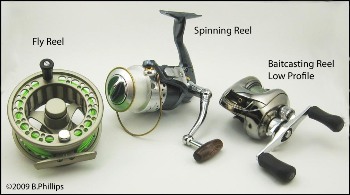

Bass Fishing Reels
Baitcast Reels
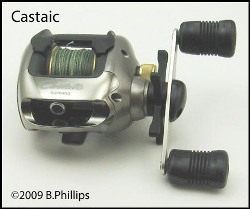
Baitcasting reels have "revolving" spools. When a baitcaster is placed in free spool by depressing the "clutch bar" a thumb must then be placed on the spool to prevent rotation. When casting, the angler gently presses a thumb on the spool to control its speed and stop its flight when at the target.
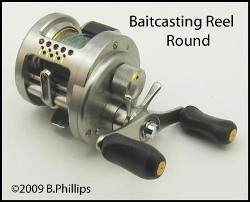
Baitcasting reels are types of fishing reels manufactured with a "level-wind" feature. This causes the line carriage to move from side to side over the spool as the handle is turned. The result is even distribution of line across the width of the spool.
Top quality reels will come equipped with a magnetic anti-backlash device to help prevent those aggravating backlashes.
Baitcasting reels are now and have been in the past the "workhorse " reel for bass fishermen. They are mechanically stronger than spinning reels and provide better casting accuracy and control. Additionally, they are better suited to fishing larger versions of spinnebaits and crankbaits.
Spinning Reels
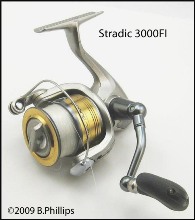
Spinning reels have a completely different construction from baitcasters. The spool is "fixed" on a shaft and does not revolve. Line is wound on the spool by a housing device with a line "pick-up bail" that revolves around the spool as the handle is turned.
Spinning reels are manufactured with handles that can be placed on either side of the reel. So right and left handers can set them up to suit there preference.
An angler casts a spinning reel by opening (lifting) the bail which puts the reel in "free-spool" allowing line to leave the spool when cast. The line is held in the crook of the first joint of the pointer finger and when cast is released freeing the line. Once the lure hits the water the bail is "closed by hand", If you merely turn the handle to engage (close) the reel you may well throw loops into you line which will cause problems on your next cast.
All types of spinning reels were originally intended for finesse situations calling for light line and lighter lures, though they are now being manufactured to handle much tougher and more demanding fishing situations.
Important Reel Features
When you go shopping for a new reel I bet you pick it up and spin the handle to test the "smoothness" of its action. I do the same. But really, there is far more to consider than this with all types of fishing reels when deciding on the one that will deliver the performance you desire.
Other features, in no particular order, that demand your attention are the following. Let's take a look at each.
Line Capacity (spool size)
Gear Ratio
Number of Ball Bearings
drag
Brakes
Weight
Line Capacity - Don't Overfill
All reel manufacturers will indicate on all types of fishing reels they manufacture the maximum amount of line that should be spooled on a reel. This varies for each size line for which a reel is rated. However, just because the ratings for a reel indicate it's designed for a capacity of 130 or 150 yards of line doesn't mean you are legally bound to spool that much.
A common mistake made by many anglers is "overfilling" the reel spool of all types of fishing reels. With baitcasting reels, to much line will increase your odds of getting backlashes. These are not what you want to see, especially on a good day when the bite is good. Some anglers fill their baitcasting reels to only around three quarters full. I'm one of those guys as I feel it helps me reduce the incidence of backlashing. By the way, everyone, even the pros, get backlashes so don't beat yourself up if you suffer with them. It's the natural order of the universe.
If you're flippin' and pitching you don't need full capacity line on your reel as distances to your target are usually 15-20´. Plus, your hauling the bass out of shallow water. When flippin' and pitchin' for bass you won't encounter a bass running off 100 yards of line.

BAITCASTER BACKLASH TIPS
In order to minimize the impact of a backlash on your fishing day do this. First, pull off 50-70 feet of line. At that point place a piece of black electrical tape on the spool. Then wind up the line you previously pulled off the spool. Now, if you encounter a backlash it will stop at the tape. Believe me, this will save you much time and aggravation.
What if you do get a backlash? Do this? Tighten down your "star" drag as tight as you can. Place your thumb and forefinger firmly on the spool and wind the handle several times. When the spool seizes up pull off a small amount of line till it stops and turn your handle again. Repeat this till your backlash is no more. I know it sounds counter intuitive but it really does work, most of the time.
SPOOL LINE ON YOUR SPINNING REELS CORRECTLY
Overfilling spinning reel spools will, without doubt, cause you
some heartburn. Line will spring off a spinning reel like a "Slinky"
(remember those?) stretched out of shape if the spool is overfilled. The
rule of thumb is to fill a spinning reel to within 1/8" of the lip of
the spool. Do what works best for you but if you're using a higher
test, stiffer line I suggest stopping at 1/8" or slightly more from the
spool's lip.
One way to prevent line from twisting and springing off your spinning reel be certain to spool your line correctly. Since line is placed on the packaged spools by manufacturers in a clockwise direction you must make sure you put line on in a counter clockwise direction. Insure the line is coming off the packaged spool in a counter clockwise direction. This usually means with the label of the replacement spool facing up when placed on the floor. Do this and you can be certain the line is winding on your reel spool in the same direction it was packaged by the manufacturer.
Gear Ratios
All types of fishing reels classified as baitcasting and spinning have gears. Gear ratios are an important part of a reel's performance. The gear ratio of a reel is a measure of the number of times the spool turns with one complete turn of the handle. If a reel has a 6:1 gear ratio with one complete turn of the handle the spool revolves six complete times. This translates into how much line and how rapidly line is retrieved when the handle is turned. If reels didn't have this stepped up gearing we would have to reel at warp speed to keep up with a running bass, especially one running towards the boat.
Gear ratios can range from 2:1 to as high as 7:1. The ratio of 5:1 is a good all purpose rating. Low speed reels with 5:1 gears are generally better for crankbaits and spinnerbaits.
High speed reels are good for fishing soft plastics like worms and lizards. However, you must take care to not fish them "incorrectly" when fishing soft plastics on Carolina or Texas rigs. If you work the lure by turning the handle instead of working the bait with the rod tip you may be moving your lure through the area where bass are located to quickly.
A positive aspect of high speed reels over all other types of fishing reels is that once your lure is out of the zone it can be quickly retrieved and recast maximizing your time on the water by enabling more casts into good bass habitat.
Ball Bearings
Stainless steel ball bearings give reels both a smooth action and durability. The more ball bearings a reel has the better its gears are going to operate and the smoother its action will be.
This is true in all types of fishing reels but is especially so with spinning reels. Any reel that has five or more ball bearings will most likely give you reliable performance.
Purchase reels with the highest number of ball bearings you can.

Drag, When A Drag Is Not A Drag
A reel's drag mechanism serves to allow a bass to run, dive or surge without breaking your line. It automatically feeds line to the fish enabling you to control it without worrying about having to manually feeding out line. Having a smooth functioning drag that allows line to smoothly leave the reel is critical. If a reel has a drag that slips and jerks when under pressure avoid it.
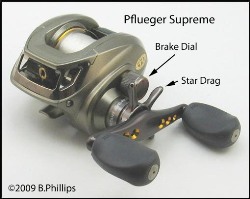
On baitcasting reels drags are adjustable with a "star wheel" located on the side of the housing.
On spinning reels, they are a "dial" located on the front or "top" of the spool. They are located at the back of the reel housing on some spinning models. Rear drag systems are not as robust as front drags and may fail to adequately perform with big fish.
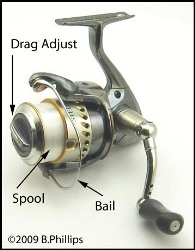
Proper drag adjustment is all important for if you set it to tight you will likely see your line break. Should it be to loose, the bass will be better able to throw your lure or wrap you around some cover. For all types of fishing reels try to set your drag tight enough that when you set the hook line does not pull off the spool because it slips. Set it so line will pull off, with some resistance, when you pull it by hand.
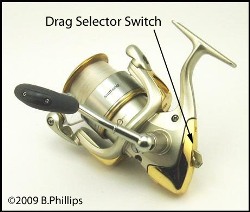
Selector Switches On Spinning Reels
Spinning reels, unlike other types of fishing reels, also have, or most have, a "selector switch" which allows an angler to move from automatic drag to manual where the angler is in full control of how much line is pulled off the reel when a fish is on. The angler reels in reverse, called "back reeling", to allow line to escape rather than forward to take it up.
Brakes
Baitcasters are types of fishing reels that come equipped with cast control systems, or what might be called "brakes". The action of these anti-backlash devices is to prevent the spool from turning faster than the lure is traveling through he air. In doing this the mechanism is supposed to help prevent backlashes. They do help, but they do not eliminate the need for thumb control of the spool when casting.
Brake systems are either (1) a knob that increases friction on the spool mechanism when tightened, (2) centrifugal or (3) magnetic. There are now types of fishing reels that use a "mini-computer" to prevent backlash. Shimano has the Calais DC and Calcutta TE DC reels which use digital circuit boards (sort of a mini computer) to monitor spool rotation and apply braking. It's very sofisticated. I have used both and my personal experience is they are extremely difficult to backlash. Unfortunately they are both a bit pricey.
Since I'm a fisherman and not an engineer I won't attempt to explain the mechanics of each type braking system on all types of fishing reels. Suffice it to say you want one of these systems on your baitcasting reel.
Weight
With today's lightweight metals and composite materials found in all types of fishing reels the "actual" weight of a reel is not as crucial to enjoyable fishing as it once was.
The weight of all types of fishing reels becomes important relative to "balancing" your complete rod and reel rig. What is important is matching your reel with a rod that creates a "balanced" outfit when placed on you index finger at a point just forward of the reel. Don't mix light-action reels with heavy-action rods and vice-versa if you want high casting performance.

Fly Fishing Reels
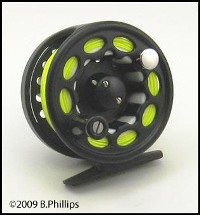
Fly reels, as one of the types of fishing reels used for bass fishing, are not as sophisticated a piece of equipment as are baitcasting and spinning reels. Some opinions are that the reel is nothing more than a device for holding line. So they say an angler fly fishing for bass should use the least expensive reel with a simple click drag.
For bass fishing, a reel that is single action is sufficient but a multiplier is better. It should have a large ardor, an adjustable disc drag, and exposed spool rims to facilitate braking. Don't risk losing a trophy bass due to an inexpensive, inadequate reel.
Though small bass can be landed by "stripping" line larger bass should be retrieved using your reel so when a big bass is at issue it becomes more than a simple device to hold your line. Bass don't usually make long runs but they do make, especially smallmouth, quick, short runs for cover or deeper water. Two features become important here, drag and reel size. A drag that can't be adjusted to suit conditions may be to tight or to loose and result in breakage of the tippet. A large arbor reel accommodates more backing and larger fly line which translates into faster and more powerful retrieves.
Since you should be able to fish on the surface, at mid-depth and also in deep water, be sure to have two extra spools loaded with sinking tip and full-sinking line.
How many types of fishing reels are there?
In summary, there are three types of fishing reels manufactured. However, the features available on bass fishing reels are many and they vary greatly in quality. Take time to learn and compare the quality and features of all you are considering purchasing.
Return To Bass Fishing Tackle From Types Of Fishing Reels
